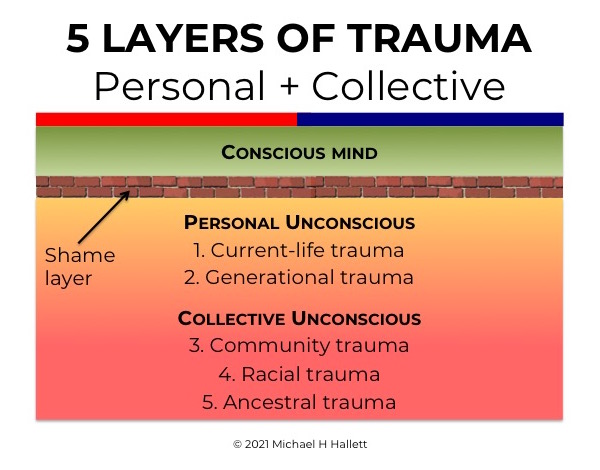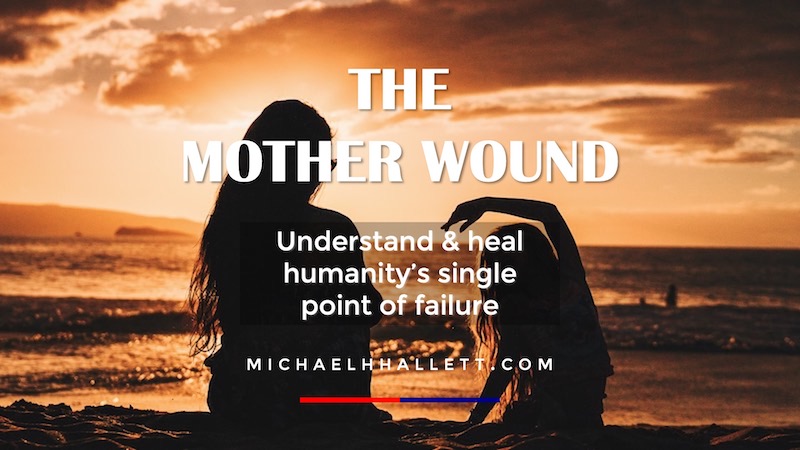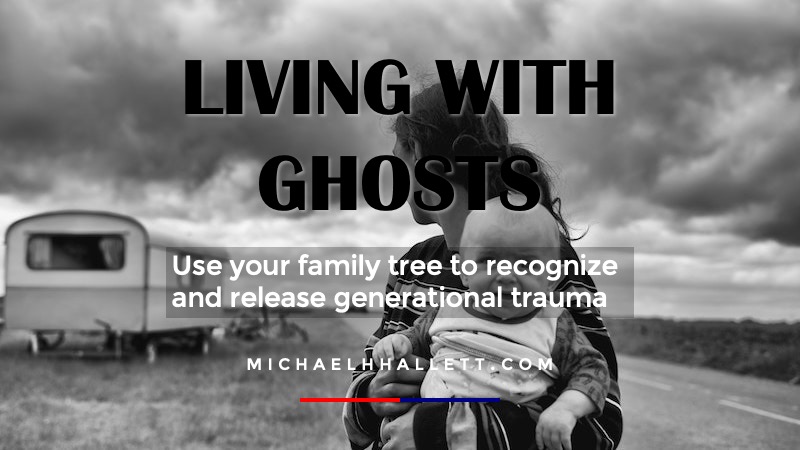Trauma exists as a series of ripples
- 15 February 2021
- Posted by: Michael H Hallett
- Category: Ancestral trauma , Generational trauma , Mother wound ,

In mid-2018 I wrote a blog titled The 3 layers of trauma – ancestral, generational, current-life, in which I ascribed all trauma to one of these categories. Fast forward 18 months and the 2021 Intergenerational Trauma Conference (ITC). I’m now seeing trauma in a much more nuanced way. There are key layers—5 of them—but it’s more accurate to describe trauma as ripples that disrupt our wellbeing.
There are key layers to trauma—5 of them—but it’s more accurate to describe trauma as ripples that disrupt our wellbeing.
Trauma ripples
Speaking at the ITC, Peter Levine referred to trauma as “a rupture in the fabric of connectivity.” Every ripple is a rupture that collides with, compounds and contaminates every other ripple. Each ripple diminishes our connectivity and increases both our sense of alienation and the difficulty of overcoming inherited trauma. (Inherited trauma is referred to as generational trauma, intergenerational trauma and trans-generational trauma. I prefer the shortest version.)
Where each ripple begins and ends is ultimately unknowable, even unimportant. The key thing is to understand the framework of the main layers as signposts to where we might find sources of trauma in our lives.
Layers of trauma
In The 3 layers of trauma, I divided trauma into (1) current-life traumatic events, (2) generational trauma inherited from our immediate ancestors, and (3) ancestral trauma inherited from our distant ancestors.
While this is still accurate, for diagnostic purposes it’s more useful to think of five key layers, as shown in this graphic. Some of this trauma is personal to us, while some of it is shared with wider and wider circles—the ripples—of our extended communities.

1. Current-life trauma
Current-life traumas are the emotional wounds (and the coping mechanisms to manage them) you’ve acquired over the course of your life. These can range from high visibility, high impact traumas such as rape to low visibility—though not necessarily low impact—traumas.
For example, I grew up in a house with an angry father, which created a continuous sense of imminent, though not necessarily actual, danger that was ultimately traumatic.
2. Generational trauma
All inherited trauma can be described as generational trauma or even ‘family trauma’ as we inherit it from our parents. Yet not all of this comes from events that directly happened to them.
Here I use the term ‘generational trauma’ to describe traumatic events that happened to the most recent 2 to 4 generations of our families. Events like divorces, sex scandals, financial failures, or war experiences that were too traumatic to handle. The shame and pain of these events are passed down as if they happened to us.
3. Community trauma
The next of the trauma ripples is community trauma. This is trauma that affects an entire community. Peter McBride, Director of the Cohen Center for Holocaust and Genocide Studies, spoke at the 2021 ITC about community trauma in Northern Ireland. He described “a political system that reinforces the divisions of the past and is incentivised to do so.”
As time goes on, the source of this trauma becomes less evident. “Communities can eventually ‘forget’ or minimise the source of their trauma, while still exhibiting their embedded trauma identity,” says McBride.
Other examples of community trauma include the LGBT+ and transgender communities, perpetually war-torn communities, and impoverished communities.
4. Racial trauma
At ITC 2021, Professor Kenneth V. Hardy spoke passionately about the collective impact of trauma on people of colour, and how that related to the Black Lives Matter movement.
Hardy observed that racial trauma “is a by-product of perpetual exposure to oppressive conditions”. It is “hardly ever acknowledged, almost never named… When a phenomenon is not named, it is not acknowledged; when it is not acknowledged it is not considered legitimate; when it is not considered legitimate, it’s hard to treat.”
“There’s a value in naming racial trauma,” says Hardy, because we avoid naming it to avoid dealing with it. The same is true of all trauma, though the deeper and the more widespread the trauma, the greater the reluctance to acknowledge it.
5. Ancestral trauma
The term ancestral trauma refers to unprocessed traumas arising from the dawn of the patriarchal age that have been handed down through epigenetic inheritance ever since.
Ancestral trauma is a significant driver of toxic masculinity. For thousands of years, male violence was socially glorified. Male sexuality was expressed through the violent conquest of wives, mistresses and the enslavement of their defeated enemies’ womenfolk.
The psychological legacy of our patriarchal past has never been fully acknowledged, accepted and healed. It surfaces today in various forms, including BDSM practices and an attraction to pornography depicting the subjugation and exploitation of women.
The mother wound
Underlying all these ripples of trauma lies a single phenomenon—what I call the mother wound. The mother wound is a failure of healthy nurturing that happened to humanity around 6,000 years ago, giving rise to violent, hierarchical, male-dominant patriarchy.
All traumas are downstream from this cataclysmic event. All efforts at healing trauma ultimately lead us to healing the mother wound. As Peter McBride said at ITC 2021, “trauma is everywhere.”
ONLINE COURSE
ONLINE COURSE

Photo by Johnny Brown on Unsplash

